Streets for People / 10 Things to Make It Safer to Bike from the 667 New Housing Units on Stock Island to Key West
There are 667 new housing units scheduled to open on Stock Island beginning this September and rolling out over the next two years. Traffic over the Cow Key Bridge is sure to increase as most work, shopping and entertainment trips into Key West will be made by car. We’ve made the argument that the City and County need to invest in improving the awful transit options that currently exist between the two islands to alleviate some of the expected traffic. Since the distance between these new housing projects and the Historic Seaport and Duval Street are between 4 and 5 miles, many of these trips could be made by bike. So, we’re making the case to also focus on improving the safety and ease of bicycling between these new housing developments and downtown. Here’s 10 things we can do to help achieve more bikes and less cars over the Cow Key Bridge daily.
New Housing Coming to Stock Island Means More Traffic
Construction has been moving along briskly at the 280-Unit Wreckers Cay at 6155 2nd Street – adjacent to Boyd’s Campground. Tenants are expected to start moving in about September 1, 2022, and officials say they’ll bring the eight new buildings online at about one a month or so with the project being fully occupied by this time next year. The Key West Housing Authority’s 104-unit Garden View Apartments on College Road is under construction and should come online in late 2023.
Just a few weeks ago we learned that Roy’s Trailer Park at 6500 Maloney Avenue gave their 108 owners notice they have six months to relocate because the property will be redeveloped from 108 trailers to 240 workforce apartments. That’s a net of 132 additional housing units at Roy’s bringing the total of new workforce housing units on the island to 516. Add in the 148-transient condos and 3 workforce condos – total 151 – recently approved at the Key West Harbor Yacht Club, also on Maloney Avenue, and that’s 667 new units and a ton of potential new cars crossing Cow Key Bridge. There’s a lot of concern about traffic, especially along U.S. 1, because visitor traffic is increasing too.
Transit Between the Islands is Awful, We Don’t Know When It Will Get Better, So We Need More Options
The likelihood that all these new residents will use transit instead of driving is almost nil. At least with today’s transit system. Census data shows less than 1% of current residents use the bus to get to work. Buses come along every 95 – 120 minutes on the Lower Keys Shuttle and every 80 – 95 minutes on the North and South Line routes that serve Stock Island. That kind of unreliable service isn’t going to entice anyone out of their car. It would be great if leaders would follow their own multiple plans to invest in the bus system to add frequency. With buses coming along every 15 minutes, maybe even every 30 minutes, perhaps some new residents could be coaxed from their cars. That would be great. But whether or not transit improves, we should also be doing more to get a portion of able-bodied people to choose to use bicycles or e-bikes and e-scooters for some of their work, shopping and leisure trips between the islands.
Four to Five Miles By Bike Should Be Easy for Some People to Traverse
It will be 4 miles from the new Garden View Apartments to the Historic Seaport or about 4.3 miles to the middle of Duval Street via N. Roosevelt Boulevard. Or 21 to 23 minutes by bike, according to Google Maps. A similar trip from Wreckers Cay would be 4.7 miles and 25 minutes via N. Roosevelt or about 5.3 miles and 30 minutes via the Crosstown Greenway down the middle of the island. For the Roy’s Trailer Park and Key West Harbor Yacht Club you’d add in another half mile. All of these are well within everyday biking distances for most able-bodied people, especially as the trip is flat and there’s good weather 12 months a year. Use an electric bike and you likely match the 13 – 19 minutes you can traverse these routes via car. That and you shouldn’t have to worry about finding and paying for parking at the downtown end. Bottom line is lots of people could use bikes, especially if it were easier and safer.
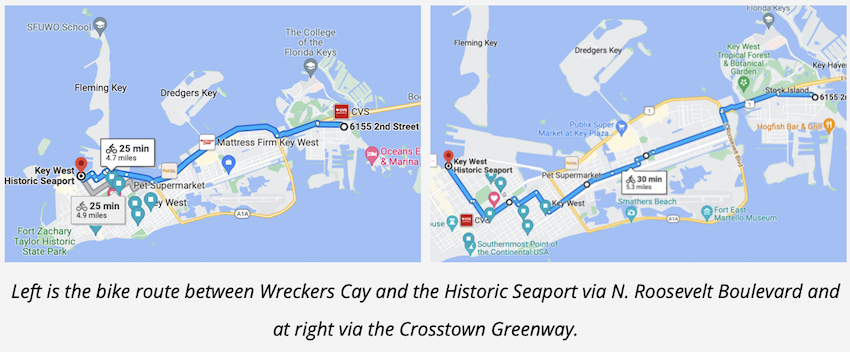
The Key is Making the “Interested But Concerned” Potential Bicyclists Feel Confident in Making the Trip Between the Two Islands
According to stats provided by the City’s Transportation Coordinator, about 1,000 trips a day cross the Cow Key Bridge using the bike path and sidewalk on either side of the road. That would translate to about 500 people a day going back and forth. That’s pretty good. But how do we get more? Especially some of the new residents who will be starting new habits – which experts tell us is the best time to get someone to try a new transportation option.
In transportation planning circles several studies have coalesced around a generally accepted categorization of people’s willingness to use bicycles as follows:
1 – Strong and Fearless: People willing to bicycle with limited or no specific bike infrastructure
2 – Enthused and Confident: People willing to bicycle if some specific bicycle infrastructure is in place
3 – Interested but Concerned: People willing to bicycle if high-quality bicycle infrastructure is in place
4 – No Way, Now How: People unwilling to bicycle even if high quality infrastructure is in place
According to three major studies, 31 – 37% of people will never use a bike for transportation. Another 8 – 13% are included in the Strong and Fearless and Enthused and Confident categories. These are likely the people already cycling across the bridge. But by far the biggest category, between 51 and 60% in the studies, say they are “Interested But Concerned” and will bike if we make a network of facilities where they feel safe and comfortable. Or high comfort and low stress. While the terms are subjective, planners generally note that continuous or networked trails, protected bicycle lanes and greenways are the kinds of facilities that will attract riders. If there are serious stress points or interruptions in that network, things can fall apart.
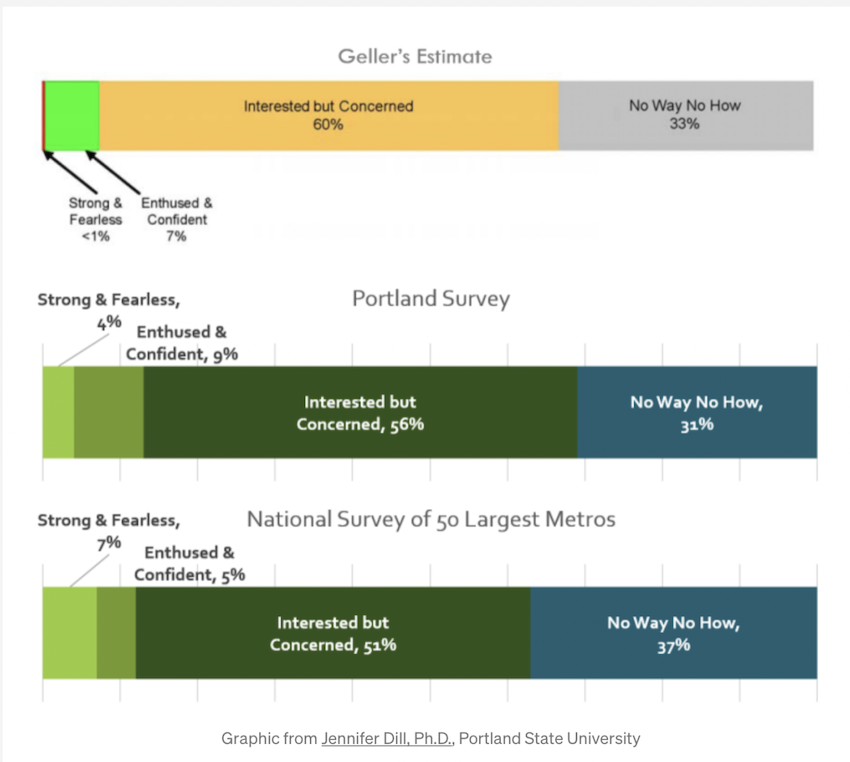
Now think about the bicycle ride into town from Stock Island. While we can identify some nice, safe, comfortable sections, we can also identify just as many stress points that may prevent the Interested But Concerned from riding.
In its annual survey of best places to bike, PeopleforBikes’ Bicycle Network Analysis identifies the high stress areas on this map in red. The Key West Bike/Ped Plan uses the same map to help identify problem points to be fixed. Take a look at the red areas – we’ve got some work to do.
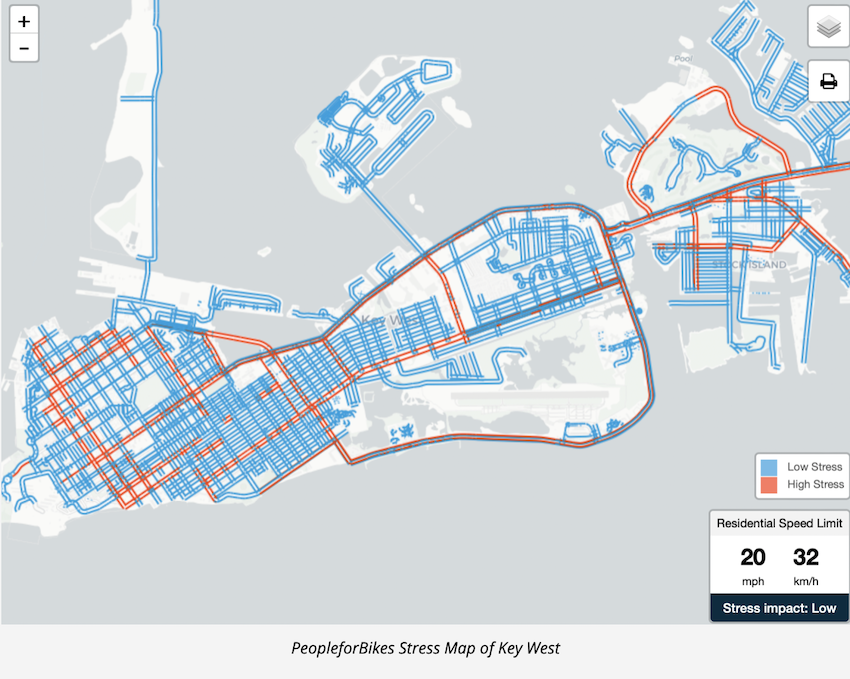
Ten Things We Can Do to Make the Trip Easier and Safer
Here’s 10 things we think could coax more of those 51 to 60% of people to bike between the two islands:
1 – Covered and Secure Bicycle Parking at New Developments
Keeping your ride dry and secure is important to many who depend upon their bicycle to get to work and get around for everyday activities. The City’s Transportation Coordinator Ryan Stachurski pointed us to this good information. We are happy to see the Housing Authority is putting 77 bicycle and 40 scooter parking spaces under the buildings, out of the elements, along with about 61 car parking spaces. In the old days, there’d be a few bike racks outside and all the covered spaces would be for cars. So, this is progress. There looks to be about another 58 car parking spaces outside and perhaps a yet to be determined amount of bicycle and scooter parking spaces outside too. While we’d like to additionally see the bikes in a secure locked cage, we think this is better than many local apartment buildings provide so we’ll count it as a victory.
At Wreckers Cay, the County’s Senior Director of Planning & Environmental Resources Emily Schemper, AICP, tell us that there will be 328 bicycle parking spaces in racks for the 280 units. She estimates that about half of these are under the cover of the buildings, per the site plan. Another win!
The recently approved permits for the 151 Key West Harbor Yacht Club condos, if we’re reading this correct, will have 229 car parking spaces for the residential units and NO required bicycle racks. Do they just assume vacationers won’t bike? This is awful and we hope to follow-up with the County.
2 – Keep Sidewalk on South Side of U.S. 1 Clear of Cars
The Stress Map clearly shows the south side of U.S. 1, where bikes on the County side of Stock Island ride along the sidewalk next to the retail is stressful. Its stressful because people on bikes must navigate cars coming to and from the businesses, pedestrians and in some cases, cars parked across the sidewalk and forcing them into U.S. Route 1. Most of the businesses, like Shifting Gears Auto Care at 5172 U.S. 1 do an admirable job of keeping the sidewalk clear. One or two don’t (Keys Customs 5200 U.S. 1 is the worst offender) and they need to clean up their act.
3 – Put Bike Lanes on College Avenue
The County has done a nice job on their side of Stock Island by putting wide, green bicycle lanes on the major streets of Maloney Avenue, 5th Street, 5th Avenue and Cross Street. On the City’s side of Stock Island, where the Garden View Apartments are being constructed, College Road lacks any bicycle infrastructure. This is evident in the Stress Map. There seems ample room for the City to rectify this safety concern.
4 – Widen Sidewalks Around the Triangle
Most of residents of Stock Island live on the south or County side. So many never navigate the long light to get over U.S. Route 1 at Cross Street and take the bike path to N. Roosevelt. Rather they simply stay on the narrow sidewalk past the retail, over Cow Key Bridge, around the bend at the Triangle and then use the Crosstown Greenway to get into town. The problem is the sidewalk is a narrow 5 feet for much of the way and is less when you encounter poles and foliage. This makes it difficult when pedestrians are present, when bikes are coming in another director or when faster bikes need to pass. There’s plenty of room to make the sidewalk wider. Especially if the Navy gives up a few feet of unused grassland behind their big chain link fence. Time for the City, County, FDOT and Navy to talk.
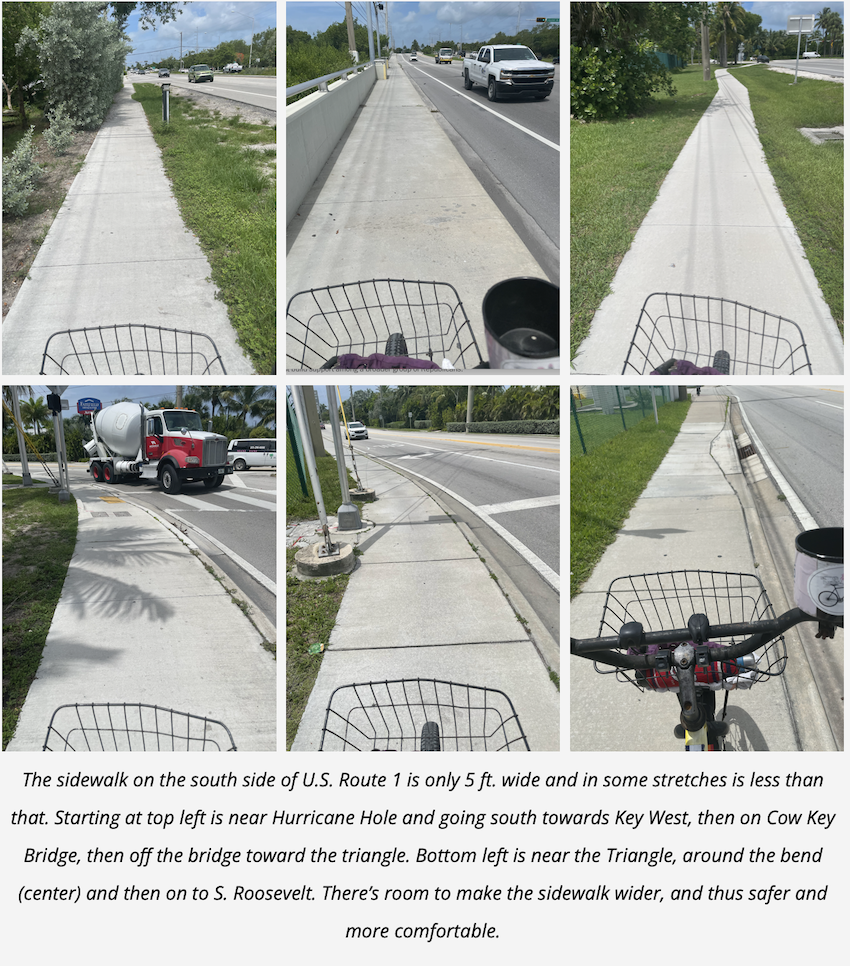
5 – Put an Official Crosswalk at Duck Avenue and S. Roosevelt Intersection
For the many people coming around the Triangle on the south side, if they aren’t going to stay on what becomes the Low Stress Promenade and go all the way around the island by the Airport and Smathers Beach to get downtown (an extra 1.3 miles out of the way), they’ll cut across S. Roosevelt to Duck Avenue and use the Crosstown Greenway. Trying to cross 4 lanes of high-speed traffic – two lanes in each direction – is the very definition of High Stress. There’s no acknowledgement in the roadway that that this is the crossing to the City’s official Crosstown Greenway. For the Greenway to be useful for people coming and going to Stock Island the intersection should be treated accordingly and made safer by demarcating it as a crossing and slowing the cars down.
6 – More Infrastructure on the Crosstown Greenway – Including Wickers Trail
We love the Crosstown Greenway because it provides a safe alternative to N. Roosevelt Boulevard to quickly get from one end of the island to the other. Starting at the top at S. Roosevelt the 3.5-mile-long trail follows Duck Avenue, wiggles through the Wickers Sports Complex (football, baseball, and soccer fields next to Poinciana Elementary) and onto Staples Avenue, Von Phister and then South Streets where it hits downtown at the upper end of Duval Street. After a series of community workshops in 2019 and 2020 in November of 2020 City staff worked with a big group of volunteers to put down green paint, directional signs, bollards, delineators and curb stops on a segment of the Crosstown Greenway on Staples between George and 12th Streets. It looked beautiful. A year later, we learned (see #10) that the project continued to receive positive comments from nearby residents and businesses and a survey showed increases in intersection safety and vehicle speed reductions. Additional phases of similar treatments are supposed to come to the rest of the Greenway. It has been more than 18 months since anything new has been put on the ground. We’d like to see the City double-down on the already good work and do so more quickly.
That includes finding more money to jumpstart the now delayed Wickers Trail segment that was supposed to have started construction by now but could be delayed until 2028. Going north on the Greenway as one comes out from the Seidenberg Avenue segment – the concrete cut-through path from Seidenberg Avenue between 12th and Kennedy – bicyclists are met with four lanes of car traffic on Kennedy and then have to navigate two parking lots at Wickers Sports Complex before getting onto Duck Avenue at 14th Street. The new segment is supposed to line up and make a safe crossing of Kennedy’s four lanes of cars and bypass the parking lots to get to Duck. Money had been budgeted but preliminary engineering found that to mitigate the standing rainwater that often floods the area, another $300,000 would be needed for the project. That $300,000 could potentially be found via an FDOT grant but wouldn’t be available until 2028. We like the idea of mitigating the standing water but think the City should find the money in the upcoming budget and get the project completed in the coming fiscal year. We promise to take a deeper dive into this story over the summer.
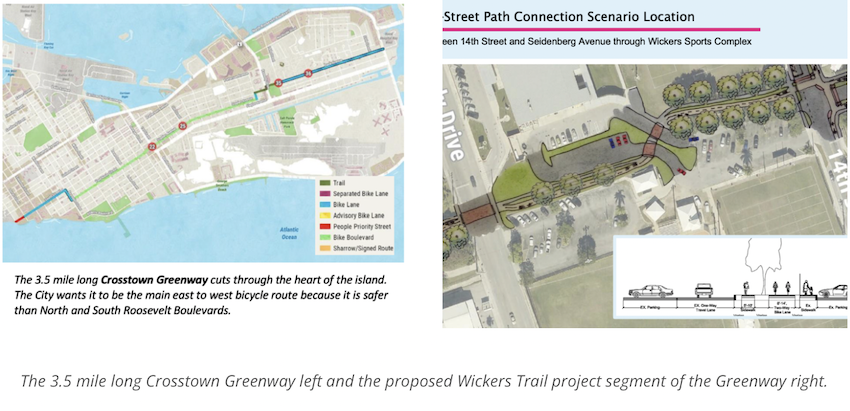
7 – Make N. Roosevelt Safer for Bicycles
For many people who live above Cow Key Bridge the shortest distance between Stock Island and downtown is N. Roosevelt Boulevard, so that’s their preference. And while the wide Promenade that makes its way along the water much of the way can be beautiful, the many retail driveways make for a stressful and sometimes dangerous commute. Especially if drivers who aren’t accustomed to bicycle traffic coming from both directions, don’t look both ways before trying to exit or enter the shopping off of N. Roosevelt. FDOT and the City made it safer when they installed the HAWK signals at five crosswalks, but there’s still much work to do make it safer. We’ve heard of nascent efforts and studies but haven’t seen anything concrete happening recently. At the very least perhaps all the driveways need green bike paint across them indicating this is a bicycle crossing. What are some other ideas to make it safer?
8 – More Quantity, Quality and Consistent Bicycle Parking Downtown
On Duval and adjacent streets, we’ve observed full bike racks and as a result bikes parked on trees, streetlights, signposts, and fences. This doesn’t help our already overcrowded narrow sidewalks. Like at the home end, safe, secure, and plentiful bicycle parking is needed all around downtown to make it easy for people to choose bicycles as an option. We need to go beyond the hodgepodge placement of racks on sidewalks and in the street to a system of bicycle corrals in the same place on every block – such as the first parking space on every street that crosses Duval – so that people know what to expect. Here’s a story on how we do that. And we need to budget some real money – not the usual annual $40K – and get this done much sooner.
9 – Educate Drivers that Bikes Rule Key West – Slow Down This Ain’t the Mainland
Educating the over million people visiting Key West each year, 77% of whom arrive by car, to watch out for and cede the way to bikes and pedestrians should be more of a priority. Most of these folks come from car-centric places where they are not used to sharing streets with so many bicycles and people. Most of them aren’t used to our crowded tiny downtown streets. If we can spend $350,000+ annually on marketing the seaport by all means we should market a car-free experience for visitors, and that campaign needs to include a safety education element that informs visitors, you aren’t on the mainland anymore. Our compact little island is different, and you need to slow down and yield to bikes and pedestrians because this is THEIR island – and that’s how we roll around here. We’ll all be safer for it.
10 – New Bicycles, E-Bikes or E-Scooters for Residents of the New Housing
Costs for e-bicycles of all kinds have been coming down for the past few years making them a good choice, especially for those living on Stock Island who must travel a little further. We Cycle and Island Bicycles both sell and service them. E-scooters can cost even less. Still a good bike can cost $500, and an electric bike could cost $1,000 or more. So how can we incentivize residents of these new complexes to take up bicycle commuting?
What if every new resident of Wreckers Cay, Garden View, and Roy’s Apartments – say about 1,000 people – were given gift certificates for new bikes that includes lights and locks. Say $500 each. That gets you a nice bike and half the cost of a new electric one. Yes, that’s a lot of money, but compared to the cost of additional bus service or the County’s consideration of spending $425,000 on a private carshare project between the islands, it doesn’t seem so much. And if we can get people to commit to biking downtown on these new bikes, perhaps its worth the investment.
We’re Flat, Compact and Have Good Weather, So Let’s Make It Even Easier and Safer to Move Between the Islands by Bike
We have great conditions in Key West and Stock Island for bicycling as we are flat, compact and have good weather 12 months of the year. 15% of us already bicycle to work. More of us should and would if it were safer and easier to do so. With much of our workforce living on Stock Island, the City, County and FDOT need to work together to mitigate the impacts of the high stress areas in our bicycle network and get more of the Interested But Concerned feeling comfortable enough to cross Cow Key Bridge on their bikes to get to work instead of defaulting to a car. We’ll all be happier if they do.
# # #
You can find a year’s plus KONK Life Streets for People column articles here and here and the most recent 2022 stories below:
- Duval Loop Ridership is Plummeting. Save the Duval Loop! June 3, 2022
- Traffic Nightmare Looms as 132 New Housing Units Added to Over 700 In the Pipeline on Stock Island and Lower Keys; May 20, 2022
- The Sorry State of Key West Bus Stops Revisited – What’s Happening a Year Later; May 6, 2022
- Ten Ways to Make Car-Free Key West a Reality for Visitors – Part 2: Services, Infrastructure and Policies; April 15, 2022
- Ten Ways to Make Car-Free Key West a Reality for Visitors – Part 1: Marketing; April 8, 2022
- ‘Greener, Cleaner Transport Act’ Says City Vehicles to Be Electric By 2030, Adds Measures to Improve Transit, Biking and Parking; April 1, 2022
- Key West Ruins Everything; March 25, 2022
- Innovative Lama E-Scooter Share Comes to Key West; March 18, 2022
- Stock Island and Lower Keys Workforce Housing Needs Frequent Transit; March 11, 2022
- We Can Adapt and Save the Florida Keys from Rising Seas; March 4, 2022
- Will Deal on Cruise Ships Finally Lead to Closing the Gap at Admiral’s Cut? February 25, 2022
- City’s On-Demand Transit Services Is Delayed Again. It’s 10-Year Plan is Scrapped Too; February 18, 2022
- Airports Need for Additional City Land Could Help Spur Salt Ponds and Smathers Beach “Locals” Bike Trails, February 11, 2022
- Too Much Surface Parking at The Lofts Is a Wasteful Use of Valuable Downtown Land; February 4, 2022
- Here’s the Real Lowdown on the Do’s and Don’ts for E-Bikes and E-Scooters in Key West; January 28, 2022
- Time to Reimagine Car-Centric, Mainland Style Searstown and Kmart into Island-Friendly Centers with Housing; January 21, 2022
- Mallory Sq., Diesel Plant, Duval Street and Bahama Village Projects Create Synergy to Bolster Downtown; January 14, 2022
- 3 Reasons You May Not Have Thought of for Voting YES on 3.2 on January 18; January 7, 2022
Chris Hamilton is founder of the local advocacy group Friends of Car-Free Key West & Duval Street/Historic Downtown. He’s a native of the District of Columbia, where for a couple decades+ he led nationally renowned efforts promoting transit, bike, walk and smart growth for Arlington County, VA’s DOT. Chris has lived in Key West since 2015. He lives car-free downtown and works and volunteers for a few non-profits. Follow him on Twitter here and his blog here.
[livemarket market_name="KONK Life LiveMarket" limit=3 category=“” show_signup=0 show_more=0]
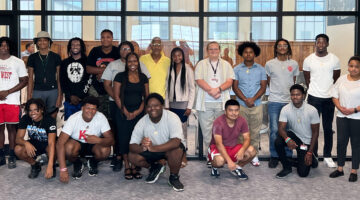
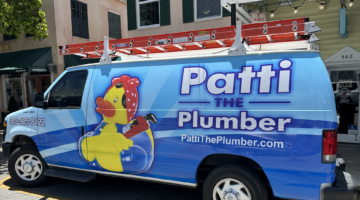
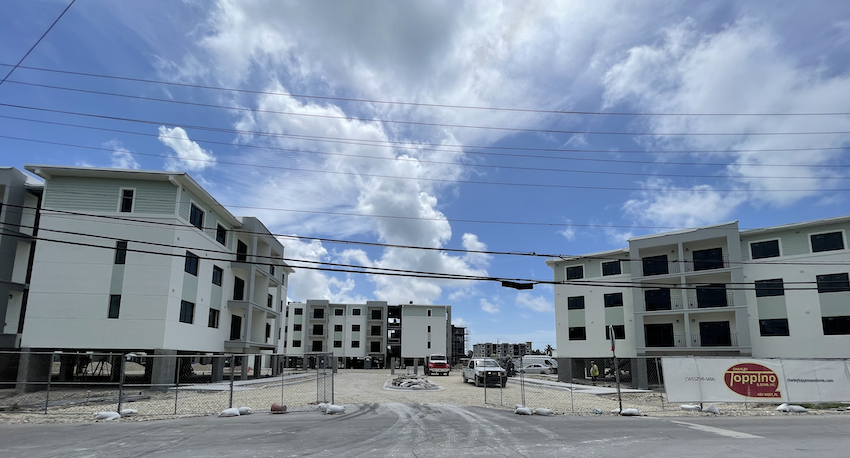

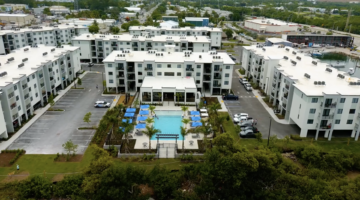
No Comment